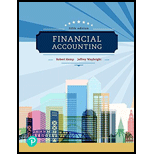
Financial Accounting (5th Edition) (What's New in Accounting)
5th Edition
ISBN: 9780134727790
Author: Robert Kemp, Jeffrey Waybright
Publisher: PEARSON
expand_more
expand_more
format_list_bulleted
Textbook Question
Chapter 8, Problem 4DQ
What is
Expert Solution & Answer
Want to see the full answer?
Check out a sample textbook solution
Students have asked these similar questions
I need help with this financial accounting question using the proper financial approach.
Need step by step answer
I am looking for help with this general accounting question using proper accounting standards.
Chapter 8 Solutions
Financial Accounting (5th Edition) (What's New in Accounting)
Ch. 8 - Prob. 1DQCh. 8 - Prob. 2DQCh. 8 - Prob. 3DQCh. 8 - What is depreciation, and why is it used in...Ch. 8 - Prob. 5DQCh. 8 - Which depreciation method would be moot...Ch. 8 - Prob. 7DQCh. 8 - Prob. 8DQCh. 8 - Prob. 9DQCh. 8 - Prob. 10DQ
Ch. 8 - Prob. 1SCCh. 8 - Prob. 2SCCh. 8 - How should a capital expenditure for a long-term...Ch. 8 - Which depreciation method usually produces the...Ch. 8 - Prob. 5SCCh. 8 - Prob. 6SCCh. 8 - Prob. 7SCCh. 8 - Prob. 8SCCh. 8 - Prob. 9SCCh. 8 - Prob. 10SCCh. 8 - Prob. 11SCCh. 8 - Prob. 12SCCh. 8 - Prob. 1SECh. 8 - Long-term asset terms (Learning Objective 1) 5-10...Ch. 8 - Prob. 3SECh. 8 - Lump-sum purchase (Learning Objective 2) 5-10 min....Ch. 8 - Errors in accounting for long-term assets...Ch. 8 - Concept of depreciation (Learning Objective 3)...Ch. 8 - Depreciation methods (Learning Objective 3) 10-15...Ch. 8 - Depreciation methods (Learning Objective 3) 10-15...Ch. 8 - Prob. 9SECh. 8 - Prob. 10SECh. 8 - Prob. 11SECh. 8 - Prob. 12SECh. 8 - Prob. 13SECh. 8 - Prob. 14SECh. 8 - Prob. 15SECh. 8 - Other long term assets (Learning Objective 8) 5-10...Ch. 8 - Prob. 17SECh. 8 - Prob. 18AECh. 8 - Prob. 19AECh. 8 - Prob. 20AECh. 8 - Prob. 21AECh. 8 - Depreciation methods (Learning Objective 3) 15-20...Ch. 8 - Prob. 23AECh. 8 - Prob. 24AECh. 8 - Prob. 25AECh. 8 - Prob. 26AECh. 8 - Prob. 27AECh. 8 - Prob. 28AECh. 8 - Prob. 29AECh. 8 - Prob. 30AECh. 8 - Prob. 31AECh. 8 - Prob. 32BECh. 8 - Prob. 33BECh. 8 - Prob. 34BECh. 8 - Prob. 35BECh. 8 - Prob. 36BECh. 8 - Prob. 37BECh. 8 - Prob. 38BECh. 8 - Prob. 39BECh. 8 - Prob. 40BECh. 8 - Prob. 41BECh. 8 - Prob. 42BECh. 8 - Prob. 43BECh. 8 - Prob. 44BECh. 8 - Prob. 45BECh. 8 - Long-term asset costs and partial-year...Ch. 8 - Journalizing long-term asset transactions...Ch. 8 - Prob. 48APCh. 8 - Prob. 49APCh. 8 - Prob. 50APCh. 8 - Prob. 51APCh. 8 - Prob. 52APCh. 8 - Prob. 53BPCh. 8 - Journalizing long-term asset transactions...Ch. 8 - Prob. 55BPCh. 8 - Prob. 56BPCh. 8 - Prob. 57BPCh. 8 - Prob. 58BPCh. 8 - Prob. 59BPCh. 8 - Prob. 1CECh. 8 - Prob. 1CPCh. 8 - Continuing Financial Statement Analysis Problem...Ch. 8 - Prob. 1EIACh. 8 - Prob. 2EIACh. 8 - Financial Analysis Purpose: To help familiarize...Ch. 8 - Prob. 1IACh. 8 - Prob. 1SBACh. 8 - Written Communication A client of yours notified...
Knowledge Booster
Learn more about
Need a deep-dive on the concept behind this application? Look no further. Learn more about this topic, accounting and related others by exploring similar questions and additional content below.Similar questions
- Should traditional accounting methods be modified when dealing with virtual transactions and digital assets? What fundamental changes might be necessary to reflect the modern digital economy?arrow_forwardPlease explain how to solve this financial accounting question with valid financial principles.arrow_forwardCan you explain the correct methodology to solve this general accounting problem?arrow_forward
- What is the labor efficiency variance for May?arrow_forwardI need help with this financial accounting question using the proper financial approach.arrow_forwardAnthropic Industries' variable costs are 40% of sales. The company is contemplating an advertising campaign that will cost $36,000. If sales are expected to increase by $90,000, by how much will the company's net income increase? a. $18,000 b. $24,000 c. $36,000 d. $54,000arrow_forward
- Please provide the correct answer to this general accounting problem using accurate calculations.arrow_forwardCan you explain the correct methodology to solve this financial accounting problem?arrow_forwardI am looking for help with this general accounting question using proper accounting standards.arrow_forward
arrow_back_ios
SEE MORE QUESTIONS
arrow_forward_ios
Recommended textbooks for you
- Principles of Accounting Volume 1AccountingISBN:9781947172685Author:OpenStaxPublisher:OpenStax College
 Cornerstones of Financial AccountingAccountingISBN:9781337690881Author:Jay Rich, Jeff JonesPublisher:Cengage Learning
Cornerstones of Financial AccountingAccountingISBN:9781337690881Author:Jay Rich, Jeff JonesPublisher:Cengage Learning Intermediate Accounting: Reporting And AnalysisAccountingISBN:9781337788281Author:James M. Wahlen, Jefferson P. Jones, Donald PagachPublisher:Cengage Learning
Intermediate Accounting: Reporting And AnalysisAccountingISBN:9781337788281Author:James M. Wahlen, Jefferson P. Jones, Donald PagachPublisher:Cengage Learning

Principles of Accounting Volume 1
Accounting
ISBN:9781947172685
Author:OpenStax
Publisher:OpenStax College

Cornerstones of Financial Accounting
Accounting
ISBN:9781337690881
Author:Jay Rich, Jeff Jones
Publisher:Cengage Learning

Intermediate Accounting: Reporting And Analysis
Accounting
ISBN:9781337788281
Author:James M. Wahlen, Jefferson P. Jones, Donald Pagach
Publisher:Cengage Learning


Revenue recognition explained; Author: The Finance Storyteller;https://www.youtube.com/watch?v=816Q6pOaGv4;License: Standard Youtube License